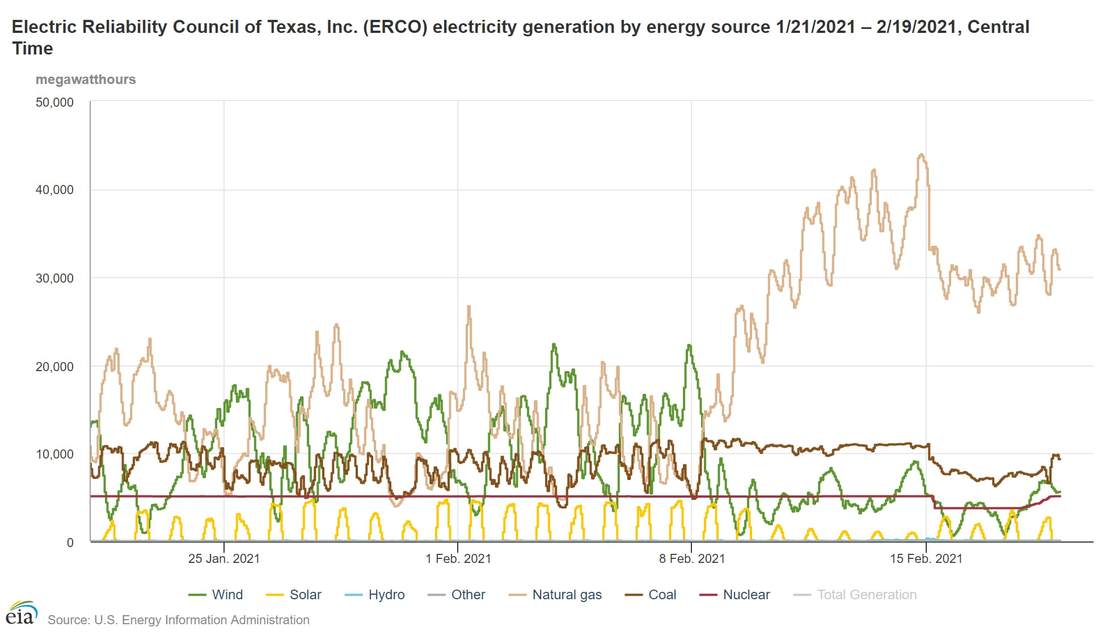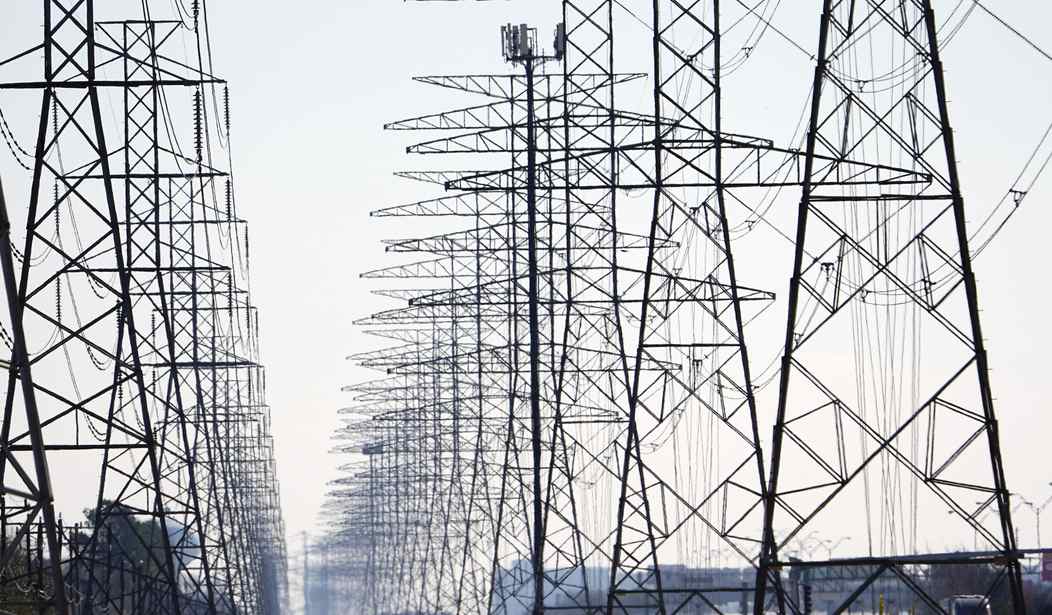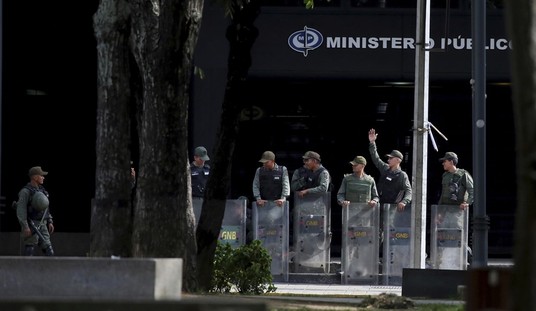And just like that, Texas went from being a deep freeze the size of a country to sunny with a high near 75. Normal service has resumed. I even had to turn up the A/C in my car while on my futile search for milk and eggs Sunday. Every state has a “Don’t like the weather? Wait a minute and it’ll change” thing, but Texas really means it. No one here would be shocked if tornadoes popped in the forecast within a couple weeks. That’s just how it is.
Last week, during the storm, we were among the few that attempted to delve into the energy output data to see what was really going on. Some asserted wind power was to blame; others, that the culprit was natural gas; still others, that Texas just hadn’t taken climate change seriously enough.
The latter was particularly unhelpful. Texas produces more wind power than the next three states combined and pushes solar hard too. If we’re not taking the idea of finding other power sources seriously, who is? That emphasis on wind has come at a cost — as we alone revealed last week, wind power did collapse in output twice during the storm. That’s what the data says, anyway.
Here’s some additional data that a lot of people didn’t want to hear about. Texas’ wind turbines sputtered in output because at least half of them froze. “Winterize ’em!” came the cry. “If Alaska can use wind power, so can Texas!”
Yeah, about that.
Alaska has about 730,000 people.
Texas has more than that just in Austin and 29 million statewide. So you’re dealing with major differences in scale and need.
Alaska’s industrial base is nowhere near the scale of that in Texas too, and while the people of the two states share much in the way of attitudes and so forth, weather is one thing we do not share at all.
You’re also dealing with the fact that Alaska really doesn’t depend on wind power. That’s in the data from the U.S. Energy Information Administration.

Wind is such a low factor in Alaska that it’s lumped in with “Nonhydroelectric Renewables,” such as solar. Hydro generates far more power, as do natural gas, petroleum, and coal, than wind. What do all those sources have in common?
A few things. They’re reliable, they’re predictable, several can be throttled to match demand, and they’re economical. Wind proponents might want to ask themselves why Alaska, which has vast coastlines and lots of wind sweeping its vast landmass, isn’t more reliant on wind to generate electricity. There must be a reason, or several. I don’t have my Official Facebook Certification in Alaskan Energy Expertise, so the reader is free to discuss, debate, and fling food as the situation warrants.
As for Texas, it currently has somewhere between 12,000 and 16,000 wind turbines in service. Winterizing them will not be quick and it will not be cheap. But it can be done and as we continue to rely on wind, we need them to produce predictably, so the legislature is sure to look hard at winterization very soon.
As I’ve written repeatedly, wind alone doesn’t account for the blackouts last week. It didn’t help much, and it wasn’t reliable, but the failures were more complex than any single factor. Life is usually like that.
One failure happened because the power companies prioritized other things than actually obtaining what’s most needed in generating power. Yahoo! Finance picked up on that over the weekend.
When the Texas power grid was on the brink of collapse and its operator plunged thousands into darkness, it didn’t make an exception for the oil and gas field.
Power was, unsurprisingly, diverted to hospitals and nursing homes. Ercot, as the grid manager is known, was staving off utter catastrophe, its chief executive later said.
But leaving shale fields like the Permian Basin dark had an unintended consequence. Producers who depend on electricity to power their operations were left with no way to pump natural gas. And that gas was needed more than ever to generate electricity.
Have a gas-powered grid? Want to collapsed that grid? Starve it of gas. Works every time.
This explains why production in the Permian fell so far so fast. At one point, production was down by about 50% out there. This obviously would impact the grid’s output and the energy markets.
A crucial part of the natural gas system was knocked out by the power outages: compressor stations that help keep gas flowing through pipelines.
As Ercot started asking utilities to prompt big customers to reduce consumption Sunday evening, those stations went down and the pressure across multiple gas pipelines started to drop, ultimately tripping some utilities off line because of lack of fuel.
As the Mythbusters used to say, there’s your problem right there. Despite this significant setback, natural gas still managed to reach about 200% of pre-storm output at several points. Here’s the EIA’s 30-day ERCOT output data up to last Friday.

Data like this tends to become a Rorschach test, some people see narratives in it that may or may not be there. One thing you don’t see there is a lot of solar output. There wasn’t much.
All that energy generation still wasn’t enough, obviously, to deal with the historic storm. One question that is being asked everywhere is, was Texas warned about this?
The answer is yes, it was.
Some point to the 2011 winter storm and that’s fair. I’ll point to the July 2019 study by the EIA and the North American Electric Reliability Corporation (NERC) pointing directly at ERCOT for being not ready to meet peak demand.
That study was conducted to examine summer energy use peaks, not winter, but nevertheless it found issues both with ERCOT’s and California’s readiness to deal with extreme demand.
“Aha!” some will say. “See, Texas, you screwed up.” Perhaps. The same folks who say that are likely to be the same folks who think Texas isn’t green enough despite the fact that it’s a wind superpower. The NERC study has something in it for everyone to hate. One reason Texas wasn’t ready was because it had recently lost a major power source.
As in previous assessments, ERCOT is the only region in the Lower 48 states where the anticipated reserve margin (8.5%) is lower than the region’s reference margin (13.8%). According to NERC, ERCOT’s anticipated reserve margin this summer is lower than last summer’s (10.9%) because of load growth, delays in new sources of electricity generation, and the announced mothballing (i.e., removal from operating service) of the 470-megawatt Gibbons Creek coal-fired plant.
Why was Texas dropping that East Texas coal plant? That part of the state has plenty of coal. But coal is dirty and out of favor. Wind and natural gas were both beating that particular energy source, but each took different paths to victory. Natural gas was winning the old fashioned way, by being more economical. Wind was winning by being politically favored and being more heavily subsidized due to its renewable reputation. So the choice to emphasize wind did have negative consequences last week. It took some old reliable coal offline. There was at least one large coal-fired plant offline that could have been online. And those in authority over Texas’ grid from Gov. Abbott to the legislature were made aware almost two years ago. Most of them were in office when that study, which came under the auspices of a Texas-friendly administration, was conducted.
Related note: While the ERCOT board ought to live in Texas so they’re likely to feel the impact of their decisions, it’s on Texans to have let so many of the board reside out of state. It’s also on Texas to have paid the board extremely high salaries and to have let them appoint each other to the board. It’s on Texas not to have demanded that they have relevant expertise and understand the state. It’s convenient to blame the out-of-staters, especially when it turns out the chairman is a Green New Deal type, but who should have been managing the store here?
Texans, that’s who.
One more bit of clean-up concerns the Biden administration’s response. I am no fan of Joe Biden and haven’t been one since I’ve been aware of his mediocre, grifting existence.
The president himself did that CNN townhall event during the storm and wasn’t asked about about the winter storm. That’s on CNN, but he still should’ve said something. Some are accusing his administration of forcing Texas not to produce as much as energy as it could to keep people from freezing, and they point to an executive order that the administration issued in response to Texas’ disaster declaration. That executive order doesn’t force Texas not to produce energy. If it had, you can bet Gov. Abbott would still be yelling about it. That executive order, 202-21-1, actually allows Texas power producers a waiver to generate more power, even if they have to temporarily go beyond EPA limits to do it. Relevant passages:
A. From February 14, to February 19, 2021, in the event that ERCOT determines that generation from the Specified Resources is necessary to meet the electricity demand that
ERCOT anticipates in Texas during this event, I direct ERCOT to dispatch such unit or units and to order their operation only as needed to maintain the reliability of the power
grid in the ERCOT region when the demand on the ERCOT system exceeds expected energy and reserve requirements. Specified Resources are those natural gas, coal, or
distillate fuel oil generating units set forth on the Order 202-21-1 Resource List, subject to updates directed here and as described in paragraph D, which the Department shall
post on www.energy.gov. ERCOT is directed to update Exhibit A to its Application with the anticipated category of environmental impact (i.e. sulfur dioxide, nitrogen oxide,
mercury, carbon monoxide emissions, wastewater release, other air pollutants) by 21:00 Central Standard Time on February 15, 2021.B. To minimize adverse environmental impacts, this Order limits operation of dispatched units to the times and within the parameters determined by ERCOT for reliability
purposes. Consistent with good utility practice, ERCOT shall exhaust all reasonably and Department of Energy Order No. 202-21-1
Page 3 of 4 practically available resources, including available imports, demand response, and identified behind-the-meter generation resources selected to minimize an increase in
emissions, to the extent that such resources provide support to maintain grid reliability, prior to dispatching the Specified Resources. ERCOT shall provide a daily notification to
the Department reporting each generating unit that has been designated to use the allowance and operated in reliance on the allowances contained in this Order.
The abridged version: Texas, this isn’t a blank check for all time but do whatcha gotta do within the emergency timeframe. Biden can be criticized for saying nothing for several days as several states dealt with this emergency, but his administration did not tell Texas not to try to keep people warm.
One last item for now. We’ve all seen stories of Texans getting slapped with huge electric bills for this past week — $10,000, $17,000 or more. The lege won’t allow such bills to stand. Some of those bills surely came to customers of a company called Griddy, which sells power at as close to current market price as possible. I looked into them a few years ago after a particularly large summer A/C bill gave me sticker shock. Like wind power, such services look great when the weather is fine. But weather can cause energy prices to fluctuate. Traditional power providers factor this in so that your bill shouldn’t fluctuate too wildly from one season to the next. Services such as Griddy don’t. They can produce outlier effects, which we’re seeing in those sensational stories about extreme heating bills. They don’t service the vast majority of Texans and those bills aren’t the norm. And there will probably be some relief for people who did receive those bills, though the form of that relief isn’t determined yet.
At the end of all this, economics and the reliability of an energy source — and the lengths needed to make sure a source is reliable if it’s not at present — has to be part of the policy conversation going forward. We have prioritized emissions over the past few decades, and our air is cleaner as a result. That’s good! It’s clearly not balanced. Texas had to reckon with a historic storm and things went cattywompus fast. That shouldn’t happen again.
We have to get this right. We have to maintain and grow an energy base that’s capable of dealing with all that Texas is, from its size to its population explosion to its mercurial weather to its massive industrial base to its mix of urban and rural, to everything else that’s unique to the place. If we fail to do that, we’ll make bad policy on an extreme event and end up worse off than before.
Bryan Preston served as chief of staff to Texas Railroad Commissioner Ryan Sitton. The Texas Railroad Commission regulates oil and gas production in the Lone Star State, which is the nation’s top energy-producing state. He is the author of Hubble’s Revelations: The Amazing Time Machine and Its Most Important Discoveries. He’s a veteran, author, and Texan.
Did Wind Power Fall Hard During the Great Texas Storm? Yep. Twice.
FEMA Sends Wind and Solar—No, Wait, It’s Sending Diesel Generators—to the Texas Winter Storm Zone









Join the conversation as a VIP Member